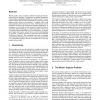Free Online Productivity Tools
i2Speak
i2Symbol
i2OCR
iTex2Img
iWeb2Print
iWeb2Shot
i2Type
iPdf2Split
iPdf2Merge
i2Bopomofo
i2Arabic
i2Style
i2Image
i2PDF
iLatex2Rtf
Sci2ools
CA
2002
IEEE
2002
IEEE
Evaluating Video-Based Motion Capture
Motion capture can be an effective method of creating realistic human motion for animation. Unfortunately, the quality demands for animation place challenging demands on a capture system. To date, capture solutions that meet these demands have required specialized hardware that is invasive and expensive. Computer vision could make animation data much easier to obtain. Unfortunately, current techniques fall short of the demands of animation applications. In this paper, we will explore why the demands of animation lead to a particularly difficult challenge for capture techniques. We present a constraint-based methodology for reconstructing the 3D motion given image observations, and use this as a tool for understanding the problem. Synthetic experiments confirm that these situations would arise in practice. The experiments show how even simple visual tracking information can be used to create human motion but even with perfect tracking, incorrect reconstructions are not only possible ...
| Added | 14 Jul 2010 |
| Updated | 14 Jul 2010 |
| Type | Conference |
| Year | 2002 |
| Where | CA |
| Authors | Michael Gleicher, Nicola J. Ferrier |
Comments (0)

